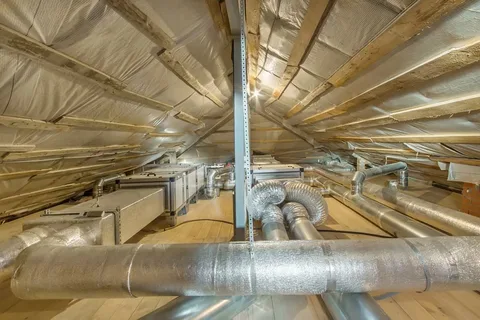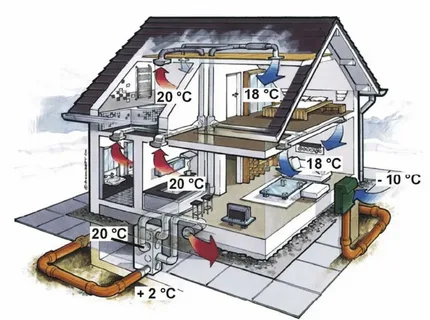In today’s world, indoor air quality is becoming increasingly important. As more people spend most of their time indoors, ensuring proper ventilation in homes has never been more crucial. One way to achieve this is through whole house ventilation. These systems are designed to provide fresh, clean air throughout the entire home, helping to improve indoor air quality and create a healthier living environment.
What Is Whole- house ventilation?
Whole- house ventilation systems are sophisticated solutions designed to ensure continuous fresh air flow throughout residential spaces. These innovative systems facilitate the exchange of stale indoor air with fresh outdoor air, thereby significantly reducing the levels of pollutants, allergens, and excess moisture within the dwelling.
The principle underlying these systems revolves around the strategic movement of air, ensuring that every room receives an adequate supply of fresh air. This not only helps mitigate the accumulation of harmful substances in the indoor environment but also plays a pivotal role in maintaining a comfortable and healthful atmosphere for inhabitants.
Essential for modern living spaces, whole-house ventilation systems stand out as a proactive approach to safeguarding indoor air quality, contributing to the overall well-being of occupants by offering a cleaner, more breathable air supply.
The Science Behind Ventilation Systems
The workings of whole-house ventilation systems are based on the concept of air exchange, which is essential for maintaining indoor air purity. Using a combination of fans and ductwork, these systems are skilled at introducing fresh air from the outdoors while simultaneously expelling stale, polluted indoor air.
This continuous circulation process is crucial to maintaining a high air quality standard within the home, effectively reducing indoor pollutants. Through the strategic regulation of airflow, whole-house ventilation systems can ensure that the indoor environment remains not only clean but also conducive to the health of its occupants.
The mechanism by which these systems operate is both simple and efficient, relying on the balance of air intake and exhaust to create an environment free from contaminants. This exchange is vital in preventing harmful particles and moisture accumulation, which can contribute to indoor air quality issues.
The Benefits Of Full House Ventilation System
Full house ventilation system excel in energy efficiency. By recycling heat from the exhaust air to warm up the incoming fresh air, these systems significantly reduce the need for additional heating. This process substantially reduces energy consumption, leading to lower utility bills.
Enhanced Air Quality
These systems play a pivotal role in improving the air quality inside homes. By ensuring a constant supply of filtered, fresh air and removing stale, polluted air, they help reduce the concentration of indoor pollutants such as dust, pollen, and volatile organic compounds (VOCs).
Condensation Reduction
Moisture and condensation can lead to mould growth and structural damage. Heat recovery ventilation systems reduce the likelihood of condensation by maintaining an optimal humidity level inside the home, thereby mitigating the risks associated with excess moisture.
Comfort Improvement
These systems contribute to a more comfortable living environment by providing a steady stream of fresh air without creating draughts and maintaining an even temperature throughout the home.
Health Benefits
The improved air quality and humidity levels directly impact the health of occupants. Individuals suffering from allergies or respiratory issues particularly benefit from the filtered air, which can help alleviate symptoms and improve overall health.
Environmentally Friendly
Heat recovery ventilation systems offer an eco-friendly solution to home ventilation by optimising energy use and reducing dependency on heating and cooling systems. This contributes to lower carbon emissions and supports a sustainable lifestyle.
Critical Components of a Whole- house ventilation System
A whole- house ventilation system comprises several integral components, each playing a vital role in effectively circulating and purifying air within the home. Central to the system are fans, which drive fresh outdoor air into the living space while expelling stale, polluted air from inside.
Complementing the function of fans is ductwork, a network of channels responsible for distributing fresh air to various parts of the home and removing contaminated air. Filters are employed within the system to ensure the air introduced into the house is free from pollutants and allergens.
These filters capture and remove particulate matter from the air before it circulates throughout the dwelling. Additionally, controls form a crucial component, allowing occupants to adjust the settings of the ventilation system to suit their preferences, thereby ensuring its operation at optimal levels for comfort and efficiency. These components collaborate seamlessly to maintain a continuous flow of clean, fresh air in residential spaces.
 How to Choose the Right Whole- house ventilation System?
How to Choose the Right Whole- house ventilation System?
Selecting the appropriate whole-house ventilation system necessitates careful consideration of several pivotal factors. The dimensions of one’s abode play a critical role in determining the system’s capacity required to ensure efficient air exchange throughout every room. Additionally, budgetary constraints must be considered, as they directly influence the range of financially viable systems financially viable systems for the homeowner.
Specific ventilation needs must also be meticulously assessed, which may vary significantly from one dwelling to another based on occupancy levels, local climate, and the presence of any existing ventilation systems.
Engaging with a qualified HVAC technician who can offer expert advice tailored to the unique characteristics of the property and the occupants’ lifestyle is an invaluable step in this process. Their insight can guide homeowners towards making an informed decision that balances performance, cost, and energy efficiency, ultimately selecting a system that aligns with their requirements.
Installation Considerations For Whole House Ventilation System
A comprehensive evaluation by an HVAC professional is vital to determining the home’s specific requirements and ensuring the selected whole house ventilation system matches its size and layout.
System Compatibility
Ensuring the chosen ventilation system is compatible with the home’s existing heating and cooling systems is crucial for efficient operation and integration.
Building Regulations
Adherence to local building codes and regulations, including obtaining necessary permits before installation, is mandatory.
Vent Placement
Strategic placement of vents and ductwork is essential to maximise air distribution and minimise energy loss, requiring careful planning and execution.
Noise Considerations
Selecting systems that operate quietly prevents noise from becoming a disruptive issue in the household.
Energy Efficiency
Opting for systems with high energy efficiency ratings reduces environmental impact and leads to significant savings on energy bills over time.
Common Challenges and Solutions in Whole- house ventilation
Navigating through the hurdles of whole-house ventilation can sometimes be daunting for homeowners. A prevalent issue is the decline in air quality, which might necessitate upgrading the existing ventilation system or integrating supplementary air purifying devices. Another common obstacle is insufficient airflow, often due to obstructed filters or ductwork. Regular maintenance, including cleaning and replacing filters, enhances airflow and system efficiency.
Additionally, the operation of ventilation systems might lead to elevated energy expenses. To counteract this, upgrading to systems with higher energy efficiency or improving home insulation could be beneficial. Addressing these challenges effectively requires preventative maintenance and strategic upgrades, ensuring the ventilation system performs optimally while fostering a healthier indoor environment.
Innovations In Domestic Heat Recovery Ventilation Technology
The realm of domestic heat recovery ventilation technology has witnessed significant advancements, with a shift towards integrating innovative, energy-efficient features. Innovations now include systems equipped with sensors capable of detecting variations in indoor air quality. These sensors trigger automatic adjustments in ventilation rates, ensuring the indoor environment maintains optimal levels of freshness without manual intervention.
Moreover, modern systems incorporate machine learning algorithms to learn a household’s patterns, further optimising energy use and enhancing air quality. Introducing such technologies offers homeowners the dual benefits of maintaining superior indoor air quality and reducing energy expenditure.
Developing more compact and noise-reducing components has also addressed common concerns regarding space and sound, making these advanced systems more appealing and accessible to a broader audience.
Maintenance Tips For Whole House Heat Recovery Ventilation System
Maintaining the efficiency and effectiveness of whole house heat recovery ventilation system involves a few critical practices.
- One key aspect is the regular replacement of filters, which ensures the system continues to operate at its peak, keeping indoor air quality high.
- Additionally, the ductwork within the system requires periodic cleaning to prevent the accumulation of dust and debris, which can obstruct airflow and diminish the system’s efficiency.
- engaging a professional HVAC technician for an annual inspection forms another essential part of maintenance.
- Such inspections can identify operational issues before they escalate into more significant problems.
- Following these maintenance tips can prolong the lifespan of the ventilation system, ensuring it continues to provide a consistent supply of fresh air into the home whilst also maintaining energy efficiency and reducing the need for costly repairs.
Exploring Types of Whole- house ventilation
Several whole-house ventilation systems have emerged to enhance indoor air quality, each with distinct methodologies and advantages. Exhaust ventilation systems primarily remove stale air from the home, creating a slight negative pressure that is fresh to infiltrate through passive vents.
Balanced ventilation systems combine the benefits of both supply and exhaust systems, maintaining an equilibrium in air pressure while ensuring that an equal amount of stale air is exchanged with fresh air. Energy recovery ventilation (ERV) and heat recovery ventilation (HRV) systems go a step further by balancing the air exchange and conserving energy in the process.
These systems capture the thermal energy from outgoing stale air and transfer it to the incoming fresh air, reducing the energy demand on heating or cooling appliances. Each system offers unique benefits tailored to specific requirements, making it imperative that homeowners assess their needs accurately before selecting the most suitable ventilation strategy for their domicile.
Conclusion
In summary, the implementation of full house ventilation system emerges as a paramount solution for enhancing indoor air quality, thus fostering healthier living conditions. By adopting these comprehensive ventilation strategies, occupants can ensure a steady influx of purified air, significantly mitigating pollutants and allergens. Moreover, emphasising regular maintenance routines and considering innovative technologies propels these systems towards greater efficiency and effectiveness. Engaging with professional services to assess and install suitable systems further guarantees that the ventilation needs of a home are met with precision. As the awareness of indoor air quality’s impact on health continues to rise, the importance of adopting whole-house ventilation systems becomes increasingly apparent, positioning them as essential components for any contemporary home aiming to provide a safe and comfortable environment for its inhabitants.
FAQs
What makes whole-house ventilation systems preferable to localised ventilation options?
Whole- house ventilation systems offer the distinct advantage of providing consistent air quality across all rooms, unlike localised ventilation that targets specific areas. This uniform approach ensures a healthier environment by reducing pollutants and allergens throughout the home, not just in isolated sections.
How Often Should The Filters In A Full House Ventilation System Be Replaced?
The frequency of filter replacement can vary depending on the specific system and indoor and outdoor air quality. Still, generally, it is recommended to replace filters every three to six months. Regular inspection and maintenance by a full house ventilation system can provide a more personalised schedule based on the system’s performance and the occupants’ needs.
Can installing a whole-house ventilation system lead to significant energy savings?
Yes, particularly when opting for systems with heat recovery or energy recovery ventilators, as they minimise the loss of heat or cool air, thus reducing the demand for heating and cooling systems. This efficiency can lead to noticeable reductions in energy consumption and, consequently, lower utility bills.
| Other Good Articles to Read |
| Skank Blogs |
| Unreal Blogs |
| Tba Blogs |
| All City Forums |
| Dany Blogs |
| Refuge Blogs |
| The Music Blogs |
| Key Forums |
| The Big Blog Theory |
| Joe Blogs |
| Blogs 4 Me |
| Blogs Emon |
| Related Business Listings |
| Contact Directory |
| Local Business Profiles |

